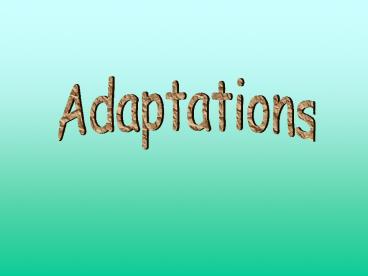Populations, Competition, Predation, Migration, Disease - PowerPoint PPT Presentation
Title:
Populations, Competition, Predation, Migration, Disease
Description:
Title: Populations, Competition, Predation, Migration, Disease Author: elsewherre Last modified by: Paula Medley Created Date: 2/18/2002 3:39:27 PM – PowerPoint PPT presentation
Number of Views:78
Avg rating:3.0/5.0
Title: Populations, Competition, Predation, Migration, Disease
1
Adaptations
2
What is an adaptation?
- An adaptation describes how a plant or animal is
able to survive in various environments - Well adapted organisms can cope with the
different aspects of their environment, for
example, the temperature
3
It is always a struggle for plants and animals to
survive
- ANIMALS STRUGGLE
- For food
- For water
- For protection against weather
- Against being eaten by predators
- Against disease
- Against accidents
- PLANTS STRUGGLE
- For water
- For light
- For minerals in the soil
- Against weather
- Against disease
- Against being eaten
4
How do adaptations help organisms?
- Well adapted organisms are better at coping with
extremes of weather - They are better at competing for food
- They are better at escaping from predators
- They are more likely to survive in their habitat
and produce offspring
5
An arctic habitat
- This sort of habitat can have extremely low
temperatures - The ground is covered with white snow for most of
the year
6
How are animals adapted to survive in the Arctic?
- Animals like polar bears will have a thick
insulating coat - They usually have a large amount of body fat
- They have a large body size to surface area ratio
- They have a camouflaged coat
7
How do these adaptations help?
- A thick fur coat
- Large body size to surface area ratio
- A large amount of body fat
- Camouflage
- Traps heat to keep warm
- Reduces heat loss by radiation
- Acts as a food store and to keep warm
- White fur is good camouflage to hide from prey
8
A desert environment
- A desert can have very little rainfall
- There is a lot of sunshine during the day
- There is very little shade
- The temperatures can get very hot
- At night it can become very cold
9
How is a camel adapted to survive in the desert?
- Camels can store large amounts of water in the
fat in their humps - They have feet with a large surface area to allow
them to walk on sand - They also have long eye-lashes to stop sand
blowing into their eyes
10
How do reptiles survive in the desert?
- Most reptiles will find some shade under a rock
during the hottest part of the day - When walking on hot sand a lizard will try to
touch the ground with only a small area - This lizard keeps swopping feet, and only stands
on two feet at a time - This snake keeps a loop of itself off the ground
as it moves across the sand sideways
11
How do plants survive the desert?
- A cactus has a long tap root to reach water deep
under the ground - It has a thick, fleshy stem to store water
- It has needle-shaped leaves to prevent water loss
through the stomata - The needles help to stop animals from eating it
12
This powerpoint was kindly donated to
www.worldofteaching.com http//www.worldofteac
hing.com is home to over a thousand powerpoints
submitted by teachers. This is a completely free
site and requires no registration. Please visit
and I hope it will help in your teaching.
13
How An Adaptation Can Lead to Natural Selection
- The Story of the Peppered Moth
- Two versions of the same species of moth
- Peppered Moth Game
- Evolution of Sickle Cell
14
Artificial Selection
- Breeding by man for specific traits. Examples
breeding for the most meaty cows, breeding for
the sweetest corn, and the most familiar DOGS!!!































